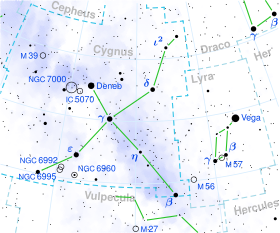天津二
天津二(天鹅座δ ,英语:Delta Cyg,缩写δ Cyg)是一颗联星,其组合星等是天鹅座的第三亮星。它也是北十字 (星群)的一部分,其中最亮的恒星是天津四(天鹅座α)。根据在依巴谷卫星任务期间获得的视差量测,天津二距离太阳大约165光年(51秒差距)[1]。
| 观测资料 历元 J2000 | |
|---|---|
| 星座 | 天鹅座 |
| 星官 | 天津(女宿) |
| 赤经 | 19h 44m 58.47854s[1] |
| 赤纬 | +45° 07′ 50.9161″[1] |
| 视星等(V) | 2.87[2] |
| 特性 | |
| 光谱分类 | A0 IV[3] (B9 III + F1 V[4]) |
| U−B 色指数 | –0.10[5] |
| B−V 色指数 | –0.02[5] |
| 变星类型 | Suspected[6] |
| 天体测定 | |
| 径向速度 (Rv) | –20.1[7] km/s |
| 自行 (μ) | 赤经:+44.07[1] mas/yr 赤纬:+48.66[1] mas/yr |
| 视差 (π) | 19.77 ± 0.48[1] mas |
| 距离 | 165 ± 4 ly (51 ± 1 pc) |
| 绝对星等 (MV) | −0.74[8] |
| 轨道[9] | |
| 主星 | A |
| 伴星 | B |
| 绕行周期 (P) | 780.27 yr |
| 半长轴 (a) | 3.0" |
| 偏心率 (e) | 0.4670 |
| 详细资料 [10] | |
| 质量 | 2.93 M☉ |
| 半径 | 5.13 R☉ |
| 表面重力 (log g) | 3.49 |
| 亮度 | 155 L☉ |
| 温度 | 10,150 K |
| 自转速度 (v sin i) | 135[11] km/s |
| 其他命名 | |
| 参考数据库 | |
| SIMBAD | 资料 |
天津二的两个组成部分被命名为天津二A(官方名称为Fawaris )/fəˈwɛərɪs/)[12]和天津二B。距离较远的是一颗个微弱的第三颗成员:一颗12等星,正在和其他恒星一起移动。它们一起形成一个三合星系统[13]。
命名法
编辑天津二(拉丁名称是Delta Cygni)是联星,它的拜耳名称是天鹅座δ。将这两个组成部分命名为天津二A和B是源于源于华盛顿多星目录(WMC)对多星系统使用的约定,并由国际天文学联合会(IAU)采用[14]。
传统上,天津二在国际上没有正式的名称[13]。它与天鹅座ζ、ε和γ一起,是星群北十字的横杆,属于阿拉伯语“al-Fawāris”(1604;فواس )的成员,在阿拉伯语方言中表示"骑手"[15]。在2016年,IAU的恒星名称工作组(WGSN)[16]对恒星的专有名称进行编目和标准化。WGSN决定将专有名称归属于单个恒星,而不是整个恒星系统[17]。在2018年6月1日核定天津二A的专属名称是Fawaris,现时已列入核定的恒星名称清单内[12]。
在中国,它与天鹅座γ、30、α、ν、τ和υ、ζ和ε组成一个星官“天津”,意思是“天河上的渡口”,属于28星宿的女宿[18]。因此,天鹅座δ的中文名字是天津二,表示是天津的第二颗星[19]。
性质
编辑主星天津二A是一颗蓝白色的巨星,属于光谱分类为B9[4],表面温度10,500K。它正接近其主序星生命阶段的终点,其光度为太阳光度的155倍,半径为5.13太阳半径,质量约为2.93太阳质量。像许多炙热的恒星一样,它的自转速度很快,在赤道至少为135km/s,大约是太阳的60倍[10]。
邻近的伴星天津二B是一颗黄白色F-型主序星,视星等6.33,光度约为太阳的6倍,质量约为太阳的1.5倍。这两颗恒星以157AU的平均距离和780年的轨道周期彼此互绕着[13]。
更遥远的第三颗星是一颗橙色的橙矮星,视星等为12等,质量只有太阳的三分之二[13]。
看似一颗星的天津二光谱类型为A0IV[3]。从地球上看,整个三合星系统的视星等为2.87[2]。但怀疑A和B的亮度不同。据报导,天津二A在的视星等于1951年在2.85和2.89之间变化,天津二B于1837年在6.3和8.5之间变化。但这两颗恒星的变异性尚未得到证实[6]。
北极星
编辑天津二是一颗肉眼可见的恒星,位于地球北极穿过天球的进动路径3°范围内。在大约公元11,250年的至少四个世纪里,它可能会被认为是一颗北极星,这是现时由距离进动轨迹只有0.5°的勾陈一持有的头衔。
| 前任者 | 北极星 | 继任者 |
|---|---|---|
| 天津四 | ~11,000 AD 至 ~11,500 AD |
织女星 |
其它可以成为北极星的恒星是:
参考资料
编辑- ^ 1.0 1.1 1.2 1.3 1.4 1.5 van Leeuwen, F., Validation of the new Hipparcos reduction, Astronomy and Astrophysics, November 2007, 474 (2): 653–664, Bibcode:2007A&A...474..653V, S2CID 18759600, arXiv:0708.1752 , doi:10.1051/0004-6361:20078357
- ^ 2.0 2.1 Malagnini, M. L.; Morossi, C., Accurate absolute luminosities, effective temperatures, radii, masses and surface gravities for a selected sample of field stars, Astronomy and Astrophysics Supplement Series, November 1990, 85 (3): 1015–1019, Bibcode:1990A&AS...85.1015M
- ^ 3.0 3.1 Zorec, J.; et al. Fundamental parameters of B supergiants from the BCD system. I. Calibration of the (λ_1, D) parameters into Teff. Astronomy and Astrophysics. July 2009, 501 (1): 297–320. Bibcode:2009A&A...501..297Z. S2CID 14969137. arXiv:0903.5134 . doi:10.1051/0004-6361/200811147.
- ^ 4.0 4.1 Edwards, T. W., MK classification for visual binary components, Astronomical Journal, April 1976, 81: 245–249, Bibcode:1976AJ.....81..245E, doi:10.1086/111879
- ^ 5.0 5.1 Johnson, H. L.; et al, UBVRIJKL photometry of the bright stars, Communications of the Lunar and Planetary Laboratory, 1966, 4 (99): 99, Bibcode:1966CoLPL...4...99J
- ^ 6.0 6.1 Samus, N. N.; Durlevich, O. V.; et al. VizieR Online Data Catalog: General Catalogue of Variable Stars (Samus+ 2007-2013). VizieR On-line Data Catalog: B/GCVS. Originally Published in: 2009yCat....102025S. 2009, 1: B/gcvs. Bibcode:2009yCat....102025S.
- ^ Evans, D. S., Batten, Alan Henry; Heard, John Frederick , 编, The Revision of the General Catalogue of Radial Velocities, Determination of Radial Velocities and their Applications, Proceedings from IAU Symposium no. 30 30, June 20–24, 1966, 30: 57, Bibcode:1967IAUS...30...57E
- ^ Anderson, E.; Francis, Ch., XHIP: An extended hipparcos compilation, Astronomy Letters, 2012, 38 (5): 331, Bibcode:2012AstL...38..331A, S2CID 119257644, arXiv:1108.4971 , doi:10.1134/S1063773712050015.
- ^ Malkov, O. Yu.; et al. Dynamical masses of a selected sample of orbital binaries. Astronomy & Astrophysics. October 2012, 546: 5. Bibcode:2012A&A...546A..69M. doi:10.1051/0004-6361/201219774 . A69.
- ^ 10.0 10.1 Challouf, M.; et al, Improving the surface brightness-color relation for early-type stars using optical interferometry⋆, Astronomy & Astrophysics, 2014, 570: A104, Bibcode:2014A&A...570A.104C, S2CID 14624307, arXiv:1409.1351 , doi:10.1051/0004-6361/201423772.
- ^ Abt, Helmut A.; Levato, Hugo; Grosso, Monica, Rotational Velocities of B Stars, The Astrophysical Journal, July 2002, 573 (1): 359–365, Bibcode:2002ApJ...573..359A, doi:10.1086/340590
- ^ 12.0 12.1 Naming Stars. IAU.org. [2018-06-18]. (原始内容存档于2020-04-11).
- ^ 13.0 13.1 13.2 13.3 Kaler, James B., Delta Cygni, Stars (University of Illinois), [2018-10-03], (原始内容存档于2023-03-07)
- ^ Hessman, F. V.; Dhillon, V. S.; Winget, D. E.; Schreiber, M. R.; Horne, K.; Marsh, T. R.; Guenther, E.; Schwope, A.; Heber, U. On the naming convention used for multiple star systems and extrasolar planets. 2010. arXiv:1012.0707 [astro-ph.SR].
- ^ Allen, R. H. Star Names: Their Lore and Meaning Reprint. New York, NY: Dover Publications Inc. 1963: 193, 197. ISBN 978-0-486-21079-7.
- ^ IAU Working Group on Star Names (WGSN). [2016-05-22]. (原始内容存档于2020-05-13).
- ^ WG Triennial Report (2015-2018) - Star Names (PDF): 5. [2018-07-14]. (原始内容存档 (PDF)于2019-08-23).
- ^ (中文) 中国星座神话,陈久金著,台湾书房出版有限公司出版,2005年,ISBN 978-986-7332-25-7.
- ^ (中文) AEEA (Activities of Exhibition and Education in Astronomy) 天文教育资讯网 2006 年 7 月 4 日 (页面存档备份,存于互联网档案馆)
外部链接
编辑- Marshall "Roc" Burns, My Nickname: The Mythological Roc (页面存档备份,存于互联网档案馆) - TheRoc.net
- James B. "Jim" Kaler, DELTA CYG (Delta Cygni) - STARS
- Alan M. MacRobert, Understanding Celestial Coordinates - Sky & Telescope
- Richard Powell, The Brightest Stars (页面存档备份,存于互联网档案馆) - An Atlas of The Universe
